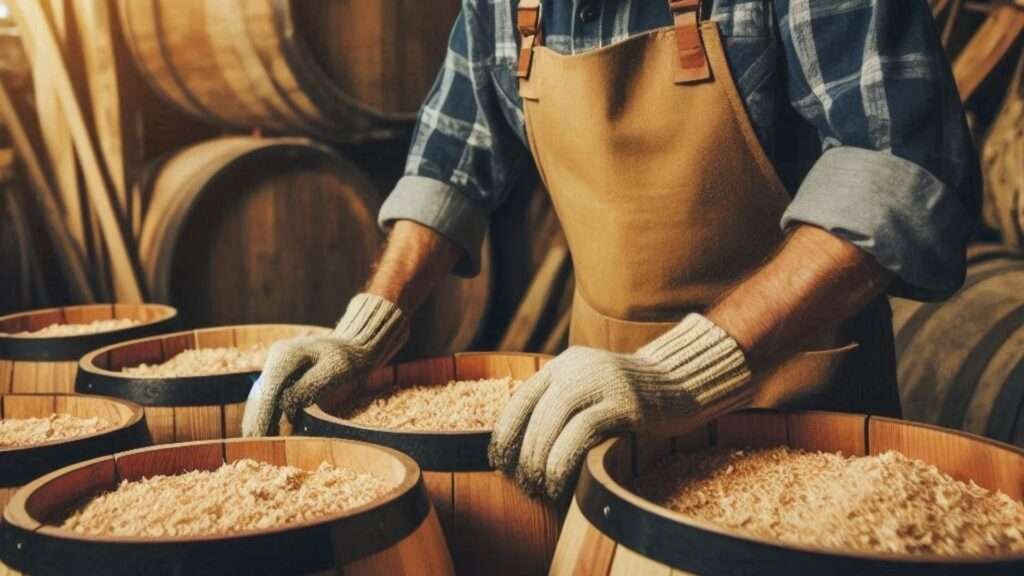Understanding The Natural Beauty Of Wood Grain.
Wood Grain can refer to a number of things, but it is most commonly associated with the way cells and fibres grow in a specific direction within the tree (wood cell/fibre orientation).
These fibres are responsible for the visible pattern known as wood grain. The fibres are the remnants of longitudinal cells that die and leave behind a cell wall as the tree grows.
Vessel elements are long, irregular cells found in hardwoods. When vessel elements are cut, tiny hollows known as pores are formed, which have an effect on grain.
Wood grain is a fundamental aspect of woodworking, is the texture and appearance of a wood’s surface caused by the growth patterns of cells and fibres within a tree.
Each tree species has distinct grain patterns that are influenced by the tree’s growth environment, age, and genetic composition.
These patterns are more than just decorative; they play an important role in determining the wood’s structural integrity and usability.
The formation of wood grain begins during the tree’s growth process. Trees grow by adding layers of cells called growth rings, which form on an annual basis.
The grain is formed by the arrangement of these cells and the types of fibres that are present.
The unique grain pattern of each tree is influenced by factors such as growth rate, environmental conditions, and genetics.
For example, slow-growing trees in dense forests typically have tighter, more uniform grain, whereas fast-growing trees in open areas may have wider, more irregular patterns.
Understanding wood grain is critical for woodworkers because it affects both the aesthetic and functional properties of the finished product. The direction of the grain influences how wood is cut, shaped, and finished.
For example, working with the grain can result in smoother surfaces & more precise cuts, whereas working against the grain can result in tear-out and rough edges. Furthermore, the grain orientation can affect the wood’s strength & stability, making it critical to choose the right grain pattern for a given application.
The visual appeal of wood grain increases the value of woodworking projects. The distinctive patterns and textures can elevate a simple piece of wood into a work of art, adding character and depth to furniture, flooring, and other wooden items.
By understanding the complexities of wood grain, woodworkers can make more informed decisions that improve the quality and aesthetic value of their creations.
Wood is both natural and beautiful.
There is nothing more appealing than wood’s natural beauty. Hardwood flooring was once considered standard in every home.
These floors were/are strong and long-lasting, but people began to cover them with carpet over time (a horrible idea).
However, the newest home improvement trend is to expose the wood floors and let their natural beauty shine through.
Butternut, pine, oak, and other woods with large pores are examples of open-grained or coarse-grained woods.
Certain types of wood absorb stain more quickly than the rest of the wood, giving it a blotchy appearance.
Straight grain can be found in Western red cedar, redwood, cypress, poplar, and aspen. Elm can be figured, but white oak and beech are usually straight.
Walnut grain patterns range from straight to patterned.
Mahogany is typically straight-grained, but it can also have distinctive patterns such as blister, stripe, or mottle. Ash has a coarse grain with dark streaks on occasion.
Closed-grained or fine-grained wood has closely spaced growth rings. They easily absorb stains and do not splotch.
Alder has a fairly straight grain with some variation in breadth. Maple, birch, and rosewood grain is typically modest and straight.
The grain of hickory can be straight or patterned, whereas the grain of cherry and poplar is fine and straight. Because of its straight grain, pine is used for furniture and flooring.
If you want to add a unique touch to a wood project, there are several ‘Figured’ woods to choose from.
These remarkable characteristics are not restricted to a single tree species. Bird’s-eye wood’s dots, or dimples, resemble eyeballs.
Fiddleback wood is distinguished by a series of ripples and is commonly used for violin backs.
Fungus produces spalted wood, which has black streaks running through it in various patterns. There are also quilt, silver, ribbon, burl, crotch, and curly figures available. Crotch wood is found where a tree’s trunk meets a large branch or another trunk. This section features swirls and motifs in the wood.
Many exotic woods have unusual grain patterns. Zebrawood is distinguished by wide, sometimes whirling dark lines. Lacewood is an Australian wood that has the appearance of hammered copper.
Tigerwood is a deep orange South American wood with striped grain that resembles tiger stripes. Cocobolo is a dark orange wood with a distinctive grain pattern and black stripes.
Because of its resistance to the elements, teak has a straight grain and is commonly used for outdoor furniture.
The Biology of Wood Grain: Cells and Fibres.
The formation of wood grain is a complex biological process that starts at the cellular level of a tree.
The wood grain patterns we see are primarily the remains of longitudinal cells, which are elongated cells that line the length of the tree.
As the tree grows older, these cells die, leaving behind their cell walls. These cell walls, in turn, create the distinctive grain patterns that distinguish different types of wood.
In hardwoods, vessel elements play an important role in shaping the grain. Vessel elements are specialised cells that transport water throughout the tree.
These vessel elements die, leaving behind hollow tubes or pores. The arrangement and size of these pores have a significant impact on the appearance of the wood grain.
For example, cutting through a hardwood log at various angles can reveal different grain patterns, which are determined by the distribution and orientation of these vessel components.
Furthermore, the density and arrangement of fibres influence the texture and appearance of the wood grain.
Fibres are another type of elongated cell that provides structural support for the tree. As with vessel elements, fibre alignment and density influence the final grain pattern.
Fibres can be densely packed in some species, resulting in a fine, smooth grain, or loosely arranged in others, resulting in a coarser texture.
Each wood species’ distinct grain patterns are determined by the combination of vessel elements and fibres, as well as other cellular structures.
Climate and soil conditions can also influence the development of these cellular structures, adding to the complexity of wood grain formation.
Understanding these biological processes provides valuable insights into wood’s natural artistry, emphasising the intricate relationship between a tree’s cellular composition and the stunning patterns that emerge as it grows.
The Impact of Sawing Techniques on Wood Grain.
Wood grain, or the inherent pattern in wood, is heavily influenced by the sawing techniques used during processing.
Understanding these techniques is essential for creating desired grain patterns and increasing the visual appeal of the finished product.
The three major types of wood grains, curly, flat, and straight grain, each have distinct characteristics that are shaped by specific sawing techniques.
Curly grain, characterised by intricate, wavy patterns, is typically achieved through quarter sawing.
This technique entails cutting the log into quarters and sawing them at an angle to the growth rings.
Quarter sawing not only highlights the beautiful curly grain patterns, but it also improves the wood’s stability and resistance to warping.
As a result, this method is preferred for high-end furniture and decorative pieces with a strong aesthetic appeal.
Plain sawing, also known as flat sawing, produces flat grain, which has broad, sweeping patterns.
This method involves cutting the log tangentially to the growth rings, resulting in a series of parallel lines and cathedrals.
Flat sawing is the most common and cost-effective method for increasing the yield of usable wood. The resulting flat grain is commonly used in flooring, panelling, and general carpentry, where its unique patterns add warmth and texture to the final product.
Straight grain, with its uniform, linear appearance, is commonly produced by rift sawing. This method involves cutting the log at a consistent angle, usually 30 to 60 degrees to the growth rings, which produces long, straight lines.
Rift sawing is less common because of its lower yield and higher cost, but the straight grain it produces is highly valued for its clean, minimalist appearance.
This grain is popular in custom millwork, cabinetry, and fine woodworking projects. The sawing technique used determines the final appearance and functionality of the wood.
Woodworkers can use the natural beauty of wood grain to create pieces that are both structurally sound and visually appealing by choosing the right method.
Variations in Wood Grain Patterns.
Wood grain patterns differ greatly depending on the tree species, growth conditions, and method of cutting.
This intricate tapestry of nature not only enhances the visual appeal of wooden products, but also influences their market value and utility in a variety of woodworking projects.
The tree species makes a significant contribution to wood grain variation. Basswood, for example, is well-known for having little visible grain, resulting in a smooth and consistent texture perfect for carving and detailed work.
In contrast, red oak has a distinct and intricate grain pattern distinguished by prominent rays and annual rings. This striking appearance makes red oak a popular choice for furniture and flooring where aesthetics are important.
Growth conditions play an important role in determining wood grain patterns. Trees grown in dense forests have tighter, more uniform grain due to slower growth rates, whereas those grown in open areas with plenty of sunlight may have wider, more irregular patterns.
The method used to cut the wood has an additional impact on the grain. Plain-sawn wood, cut parallel to the growth rings, typically shows a more wavy and varied grain pattern, whereas quarter-sawn wood, cut perpendicular to the rings, shows straighter and more consistent lines.
Understanding these variations is critical for woodworkers looking to improve the aesthetic and functional properties of their products.
Woods with minimal visible grain patterns, such as basswood, are ideal for applications requiring a smooth finish and intricate detailing.
Woods with prominent grain patterns, such as red oak, provide visual interest and are frequently chosen for their decorative appeal.
This knowledge enables craftsmen to choose the best wood type for specific projects, increasing the final product’s market value and customer satisfaction.
Highly Regarded Wood Grains and Their Characteristics.
Wood grain, also known as the texture or pattern seen on the surface of a piece of wood, is important in defining the aesthetic and functional characteristics of wooden products.
Some of the most coveted wood grains are prized not only for their visual appeal, but also for the distinct characteristics they bring to the finished product.
Oak has one of the most beautiful wood grains. Oak wood has a distinctive, coarse grain pattern that can range from straight to wavy.
This distinctive grain has a robust and rustic appearance, making it popular for furniture and flooring. Oak’s distinctive grain pattern is also extremely durable, adding to its appeal and utility.
Walnut is another highly valued wood grain. Walnut grain is characterised by its rich, dark colour and fine, straight grain patterns with occasional waves or curls. This elegant grain pattern gives walnut a luxurious appearance, making it a popular material for high-end furniture, cabinetry, and decorative items. The wood’s smooth texture and unique grain add to its refined and sophisticated appearance.
Maple wood grain, on the other hand, is valued for its subtle and consistent appearance. Maple’s grain is generally straight, but it can have interesting patterns like birdseye, flame, or quilted figures.
Maple’s visual appeal is enhanced by its unique grain patterns, making it a versatile choice for both modern and traditional designs.
Maple’s fine grain and smooth texture make it ideal for musical instruments and high-quality joinery.
Finally, mahogany is known for its straight, fine, and uniform grain. The grain pattern of mahogany is usually very consistent, which contributes to its smooth and polished appearance.
Because of its beauty and workability, this wood is commonly used in the manufacture of fine furniture and boats. Mahogany’s rich, reddish-brown colour and elegant grain make it a timeless material for creating classic and long-lasting pieces.
The appearance of wood grain significantly increases the appeal of a finished product. Grain patterns add to the uniqueness of each piece of wood, ensuring that no two items are identical.
This individuality, combined with the unique characteristics of each type of wood grain, contributes significantly to the overall aesthetic and tactile experience of wooden products.
Whether it’s the rustic charm of oak, the luxury of walnut, the versatility of maple, or the elegance of mahogany, highly valued wood grains continue to captivate and inspire Woodworkers all over the world.
Wood Grain and Wood Strength.
Understanding the relationship between wood grain and wood strength is critical in a variety of applications, including construction and fine woodworking.
Wood grain refers to the arrangement, texture, and appearance of the fibres that make up a piece of wood. The orientation of these fibres has a significant impact on the wood’s strength and durability.
When wood is cut vertically, parallel to the grain, it typically has greater strength.
This method, commonly known as “vertical grain” or “quarter-sawn,” produces a more stable and robust structure. The fibres run continuously along the length of the wood, allowing it to better withstand stress and load.
As a result, such wood is less likely to warp, split, or bend, making it ideal for structural beams, load-bearing columns, and high-quality furniture.
Conversely, wood cut perpendicular to the grain, known as “flat-sawn” or “plain-sawn,” has a more decorative appearance but is less strong. The fibres are interrupted, resulting in a visually appealing yet structurally weaker pattern.
This type of cut is more prone to expansion and contraction as humidity and temperature change, which can result in warping or splitting over time.
Stronger wood grains typically have a consistent, straight pattern with little variation. Oak, hickory, and ash are known for their dense grain structures.
These woods are frequently used for applications that require high strength and durability, such as flooring, tool handles, and sports equipment.
Wood grain characteristics influence the mechanical properties of the wood, such as its modulus of elasticity and tensile strength. Woods with tightly packed, straight grains are more resistant to mechanical stress, extending their life and performance under load.
The orientation and type of wood grain are critical factors in determining the strength and suitability of wood for various applications.
Selecting wood with the appropriate grain structure ensures optimal performance and durability, whether building a house or crafting fine furniture.
Classification of Hardwood Grains: Open vs. Closed.
Hardwood grains are generally divided into two types: open grain and closed grain.
This classification is based on the size and distribution of pores in wood. Open grain woods, like oak, ash, and mahogany, have larger, more visible pores.
These pores are visible to the naked eye, lending the wood a textured, rustic appearance.
Closed grain woods, such as maple, cherry, and birch, have smaller, tightly packed pores, resulting in a smoother and more uniform surface.
Visually, open grain woods have a distinctive texture that adds character and depth to any woodworking project.
The larger pores produce a natural pattern that can be enhanced with finishes and stains, making these woods popular for furniture and decorative pieces requiring a distinct grain pattern.
Closed grain woods, on the other hand, have a fine, even texture that makes them ideal for applications that require a sleek, refined appearance.
They are frequently used in cabinetry, musical instruments, and fine woodworking because of their smooth, consistent appearance.
Tactile differences between open and closed grain woods are also important in woodworking. Open grain woods are rougher to the touch, which can affect the finishing process.
To achieve a smooth finish, larger pores may need to be filled, and certain finishes can bring out the wood’s natural texture.
Closed grain woods, on the other hand, have a smooth surface and require less preparation to achieve a high-gloss finish. This makes them ideal for projects requiring a polished, flawless surface.
Understanding the classification of hardwood grains and their characteristics is critical for woodworkers.
It guides material selection based on both aesthetic and functional requirements, ensuring that the finished product not only looks good but also meets the desired standards of craftsmanship and durability.
Grain Orientation, Hardness, and Wood Species.
Grain orientation is critical in determining the hardness and overall properties of wood. The orientation of the wood fibres has a significant impact on its strength, durability, and aesthetic appeal.
When wood is cut parallel to the grain, it has different properties than wood cut perpendicular or at an angle to the grain.
This alignment affects not only the mechanical properties of the wood, but also its visual patterns, which are highly desirable in woodworking and furniture making.
One important factor to consider is side hardness, which is measured with the Janka hardness test. This test measures the force required to embed a steel ball into the wood, providing a consistent measure of its resistance to wear and denting.
Side hardness varies significantly across different wood species, and understanding this variation is critical for selecting the right wood for a given application.
For example, oak and maple are known for their high side hardness, making them ideal for flooring and heavy-duty furniture, whereas softer woods such as pine are better suited to decorative elements.
Identifying the wood species is critical for understanding its unique properties and potential applications.
Each species has unique grain patterns, colours, and textures that add to its overall appearance and performance.
For example, the tight, straight grain of cherry wood is valued for its smooth finish and rich colour; whereas mahogany’s interlocking grain provides both beauty and exceptional stability.
Recognising these differences allows you to make more informed decisions when choosing wood for various projects.
Understanding how different grain patterns are created helps us appreciate the complexity of wood grain.
The interplay of grain orientation and wood species produces a variety of natural designs, ranging from the straight and uniform lines of quartersawn oak to the swirling, unpredictable patterns found in burl wood.
This intricate diversity not only enhances the aesthetic value of wood, but also informs its practical applications, allowing us to fully utilise nature’s masterpiece.
The Profound Impact of Wood Grain on Cabinetmaker Timber Selections.
Wood grain refers to the arrangement and alignment of wood fibers within a tree. This characteristic is fundamental to understanding the aesthetic and functional properties of wood, particularly in cabinetmaking.
Essentially, wood grain is formed by the growth rings of a tree, which develop over the years as a result of the tree’s annual growth cycles.
These rings represent different phases of growth, influenced by environmental conditions such as climate, soil quality, and water availability.
Several distinct wood grain patterns exist, each contributing uniquely to the visual and tactile qualities of wood.
Straight grain is characterized by parallel lines running the length of the wood, offering a uniform and predictable appearance.
Wavy grain, on the other hand, features undulating lines that create a sense of movement within the wood.
Curly grain exhibits a more intricate pattern with tight curls and swirls, adding a dynamic texture to the wood surface.
Interlocked grain occurs when fibers grow in alternating directions, often resulting in a complex and visually interesting pattern that can enhance the depth and richness of the wood.
The natural variations in wood grain are influenced by several factors, including tree species and growth conditions.
For instance, hardwoods such as oak and maple typically exhibit more pronounced grain patterns compared to softwoods like pine and spruce. Additionally, environmental factors play a crucial role in grain formation.
Trees grown in areas with consistent, moderate climates tend to produce more regular and predictable grain patterns, while those subjected to fluctuating conditions may develop more erratic and unique grain structures.
Understanding the nuances of wood grain is essential for cabinetmakers, as the choice of wood and its grain pattern can significantly impact the final appearance and feel of the cabinetry.
By selecting the appropriate wood grain, cabinetmakers can create pieces that not only meet functional requirements but also enhance the aesthetic appeal of the space they occupy.
Wood Grain Patterns and Their Influence on Cabinetmaking Decisions.
Wood grain patterns shape cabinetmakers’ decisions, influencing both the aesthetic and functional aspects of cabinetry.
The visual appeal of cabinets is heavily influenced by the type of wood grain used, as it determines texture, colour variation, and overall style.
Straight, curly, wavy, and interlocked grains are among the most common grain patterns. Each pattern creates a distinct visual effect, allowing cabinetmakers to customise their designs to suit a variety of tastes and preferences.
From a functional standpoint, grain patterns directly impact the structural integrity of cabinets. For instance, straight-grain woods are often preferred for their strength and ease of working, making them ideal for load-bearing structures such as cabinet frames and shelves.
Conversely, wavy or curly grains, while visually striking, can pose challenges in terms of stability and may require careful consideration and additional reinforcement during construction.
Grain direction, whether vertical or horizontal, is another crucial factor in cabinetmaking. Vertical grain orientation is frequently chosen for cabinet doors and panels to create the illusion of height and elegance.
Horizontal grain, on the other hand, can impart a sense of width and spaciousness, making it suitable for wider cabinet designs.
The choice of grain direction can significantly influence the overall perception of space and style within a room.
Consistency and matching of wood grain are essential for achieving a harmonious and professional look in cabinetry.
Uniform grain patterns across cabinet surfaces contribute to a seamless and cohesive design. Cabinetmakers often employ techniques such as bookmatching and slip matching to ensure that adjoining panels exhibit a continuous and visually pleasing grain flow.
These methods not only enhance the aesthetic appeal but also demonstrate the craftsmanship and attention to detail inherent in quality cabinetry.
Ultimately, the careful selection and application of wood grain patterns are fundamental to the artistry of cabinetmaking.
By considering both aesthetic preferences and functional requirements, cabinetmakers can create timeless and durable pieces that elevate the beauty and utility of any space.
Selecting the Right Timber Based on Wood Grain.
When it comes to cabinetmaking, selecting the right timber is crucial, and understanding wood grain characteristics plays a significant role in this process. Wood grain, the arrangement of fibers in the wood, not only influences the aesthetic appeal but also affects the functionality and longevity of the finished product.
Therefore, a thorough evaluation of grain patterns and orientations is essential for achieving the desired outcome in cabinet designs.
Firstly, consider the type of wood species and their grain patterns.
For instance, oak and ash are known for their prominent and attractive grain, making them ideal for decorative cabinets where the grain can be showcased.
On the other hand, maple and cherry offer a more subdued grain, suitable for a sleek, modern look. The choice of wood species should align with the overall design theme and personal preferences.
Grain orientation is another critical factor. The direction in which the grain runs can significantly impact the strength and stability of the cabinet.
For structural components, such as frames and supports, a straight grain orientation is preferred as it provides greater durability and resistance to warping. Conversely, for visible surfaces like doors and panels, a varied grain pattern can enhance visual interest and character.
Inspecting timber for desirable grain qualities involves examining the wood’s surface for consistency and uniformity.
Look for boards with even grain distribution and minimal defects, such as knots or splits, which can weaken the wood and affect its appearance.
Additionally, consider the wood’s moisture content, as improper drying can lead to issues like shrinkage and cracking.
The impact of wood grain on the finishing process cannot be overstated. Different grain patterns absorb stains and finishes differently, influencing the final look of the cabinet.
For example, open-grain woods like oak may require fillers to achieve a smooth finish, while closed-grain woods like maple take stains more uniformly. Understanding these nuances helps in selecting the right finishing techniques to enhance the wood’s natural beauty.
Selecting timber based on wood grain characteristics involves a careful assessment of grain patterns, orientations, and qualities.
By considering these factors, cabinetmakers can create durable, aesthetically pleasing cabinets that meet both functional and design requirements.
Mastering Wood Grain to Elevate Cabinetmaking Artistry.
In the realm of cabinetmaking, the mastery of wood grain is essential for creating exceptional pieces that stand out in both quality and aesthetics.
The intricate patterns and textures of wood grain can be skillfully manipulated to enhance the visual appeal of cabinetry, transforming ordinary furniture into works of art. Advanced techniques such as grain matching and alignment play a crucial role in this process.
Grain matching involves selecting and positioning pieces of wood so that their grain patterns flow seamlessly across the surfaces of the cabinet.
This technique requires a keen eye and a deep understanding of the natural variations in wood grain.
By aligning the grain patterns, cabinetmakers can achieve a harmonious and cohesive look that elevates the overall design. Grain alignment, on the other hand, focuses on the direction and orientation of the wood grain, ensuring that it complements the structure & form of the cabinet.
A profound understanding of wood grain provides cabinetmakers with a competitive advantage, allowing them to create unique and high-quality designs.
For instance, a cabinet door featuring a bookmatched grain pattern, where two adjoining panels mirror each other, can create a striking visual effect. Similarly, incorporating a continuous grain pattern across multiple drawers can enhance the sense of unity and craftsmanship.
Grain-conscious construction methods also contribute to the durability and functionality of cabinetry.
By aligning the grain direction with the structural elements of the cabinet, such as the frame and panels, cabinetmakers can optimize the strength and stability of the piece. This attention to detail not only enhances the cabinet’s visual appeal but also ensures its longevity.
The artistry of working with wood grain is a continuous journey of learning and experimentation. Cabinetmakers must stay abreast of new techniques and trends, constantly pushing the boundaries of their craftsmanship.
By embracing the natural beauty of wood grain and honing their skills, they can create cabinets that are not only functional but also masterpieces of design.









[…] https://www.glzwoodw.biz/wood-grain/ […]